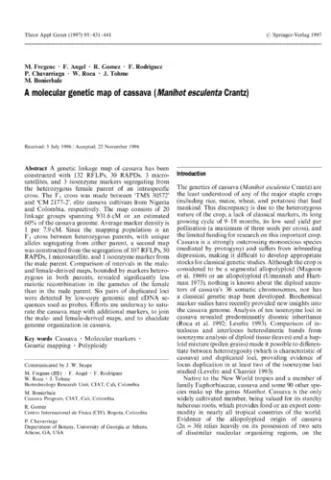A molecular genetic map of cassava (Manihot esculenta Crantz)

Abstract
A genetic linkage map of cassava has been constructed with 132 RFLPs, 30 RAPDs, 3 microsatellites, and 3 isoenzyme markers segregating from the heterozygous female parent of an intraspecific cross. The F1 cross was made between ‘TMS 30572’ and ‘CM?2177-2’, elite cassava cultivars from Nigeria and Colombia, respectively. The map consists of 20 linkage groups spanning 931.6?cM or an estimated 60% of the cassava genome. Average marker density is 1 per 7.9?cM. Since the mapping population is an F1 cross between heterozygous parents, with unique alleles segregating from either parent, a second map was constructed from the segregation of 107 RFLPs, 50 RAPDs, 1 microsatellite, and 1 isoenzyme marker from the male parent. Comparison of intervals in the male-and female-derived maps, bounded by markers heterozygous in both parents, revealed significantly less meiotic recombination in the gametes of the female than in the male parent. Six pairs of duplicated loci were detected by low-copy genomic and cDNA sequences used as probes. Efforts are underway to saturate the cassava map with additional markers, to join the male- and female-derived maps, and to elucidate genome organization in cassava.
